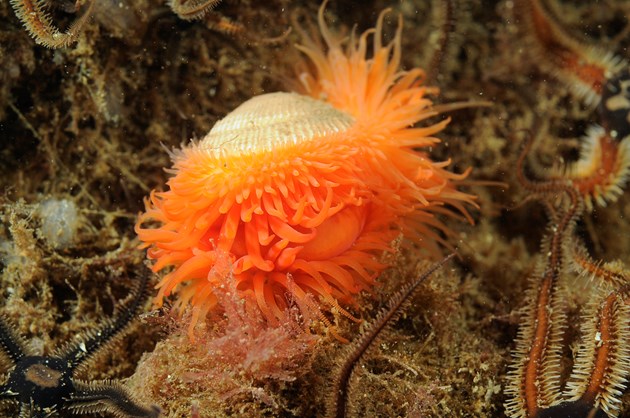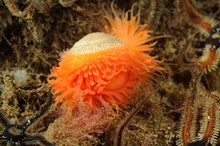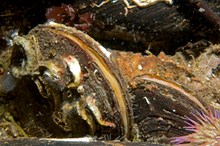16 December, 2019
Marine habitat connections revealed

The underwater connections linking some of Scotland’s most important marine habitats have been revealed like never before.
A new report published by Scottish Natural Heritage (SNH) uses state-of-the-art modelling to shed fresh light on how horse mussel beds around our coasts are linked, as well as examining the connections between flame shell beds in different locations.
Both are protected features in Scotland’s network of Marine Protected Areas (MPAs) and the study modelled the connectivity between populations in both protected and unprotected areas for the first time.
Researchers found that west coast mussel beds could be connected to other beds as far as Orkney and Noss Head. This can happen as mussel larvae ride the prevailing ocean currents and over time, intermediate beds can act as “stepping-stones” along the way.
Meanwhile flame shell beds - found mostly on the west-coast of Scotland and in Orkney’s Scapa Flow - were found to be generally weakly connected, making them more vulnerable to any local damage.
The modelling - a joint initiative between SNH, Marine Scotland Science and Heriot Watt University - suggested that horse mussels and flame shells could reach and form beds in a number of new areas in Scottish waters. Seabed surveys in these areas may confirm the model predictions.
SNH and Marine Scotland are working on a project to improve protection of sensitive habitats - including known horse mussel beds and flame shell beds - outside the MPA network.
The research will help to identify locations where additional protection could improve connectivity between these habitats. The methodology could also be used in future to predict changes in the network due to climate change.
Flora Kent, SNH Marine Ecology Adviser, said: “Horse mussels and flame shells are two amazing species that greatly increase the richness of our seas. The habitats they form provide vital shelter and structure for a range of other marine species, but they are also sensitive to disturbance.
“The new methods used in this study have, for the first time, given us a really fascinating insight into how different populations are connected all around our coasts, both inside and outside of protected areas.
“By revealing these links, the results help us to understand where additional protection could enhance this connectivity and improve the biodiversity of our seas.”
Alejandro Gallego, Marine Scotland Oceanography Group Leader, said: “This work is a good example of how numerical models of our shelf seas can be applied to understand important ecological processes in the marine environment and provide evidence to develop the marine management policies that enhance the protection of these important and sensitive species”
Contact information
- Name
- NatureScot Media
- Telephone
- 0131 316 2655
- media@nature.scot
Notes to editors
The full report can be read here: https://www.nature.scot/snh-research-report-1048-connectivity-selected-priority-marine-features-within-and-outwith-scottish
Horse mussels are similar to the blue mussels of our seashores but grow much larger, and can reach more than 15cm in length and live for over 45 years. Horse mussels can live individually or in clumps, or may form raised beds with several hundreds of mussels per square metre. Horse mussels live below the low water mark, with beds found at depths from 5 to 220 metres (although most known beds are between 20-50 metres). The beds provide a foundation for soft corals, tubeworms, barnacles, sea firs, sea mats and seaweeds, as well as shelter for brittlestars, crustaceans, worms, molluscs and many other small animals.
Flame shells live hidden on the seabed in nests, which they build from shells, stones and other materials. Hundreds of nests can combine to form a dense bed, which stabilises the seabed and provides substrate for sea firs, sea mats, sea squirts and seaweed, as well as shelter for many other creatures, such as crabs, scallops and brittle stars. The habitat is found mainly on the west coast of Scotland, often in tidal narrows and the entrances to sea lochs, with the largest known flame shell bed in Loch Carron. There is also a flame shell bed in Scapa Flow on Orkney.
The research uses the Scottish Shelf Model (SSM), a suite of hydrodynamic models of Scottish continental shelf waters which have a wide range of marine science and policy applications. More information is available here: http://www.marine.gov.scot/themes/scottish-shelf-model
NatureScot is Scotland's nature agency. We work to enhance our natural environment in Scotland and inspire everyone to care more about it. Our priority is a nature-rich future for Scotland and an effective response to the climate emergency. For more information, visit our website at www.nature.scot or follow us on X at https://x.com/NatureScot
’S e NatureScot buidheann nàdair na h-Alba. Bidh sinn a’ neartachadh àrainneachd na h-Alba agus a’ brosnachadh dhaoine gu barrachd suim a chur ann an nàdar. Tha e mar phrìomhachas againn gum bi nàdar na h-Alba beairteach agus gun dèilig sinn gu h-èifeachdach le èiginn na gnàth-shìde. Tha an tuilleadh fiosrachaidh aig www.nature.scot no air X aig https://x.com/NatureScot


